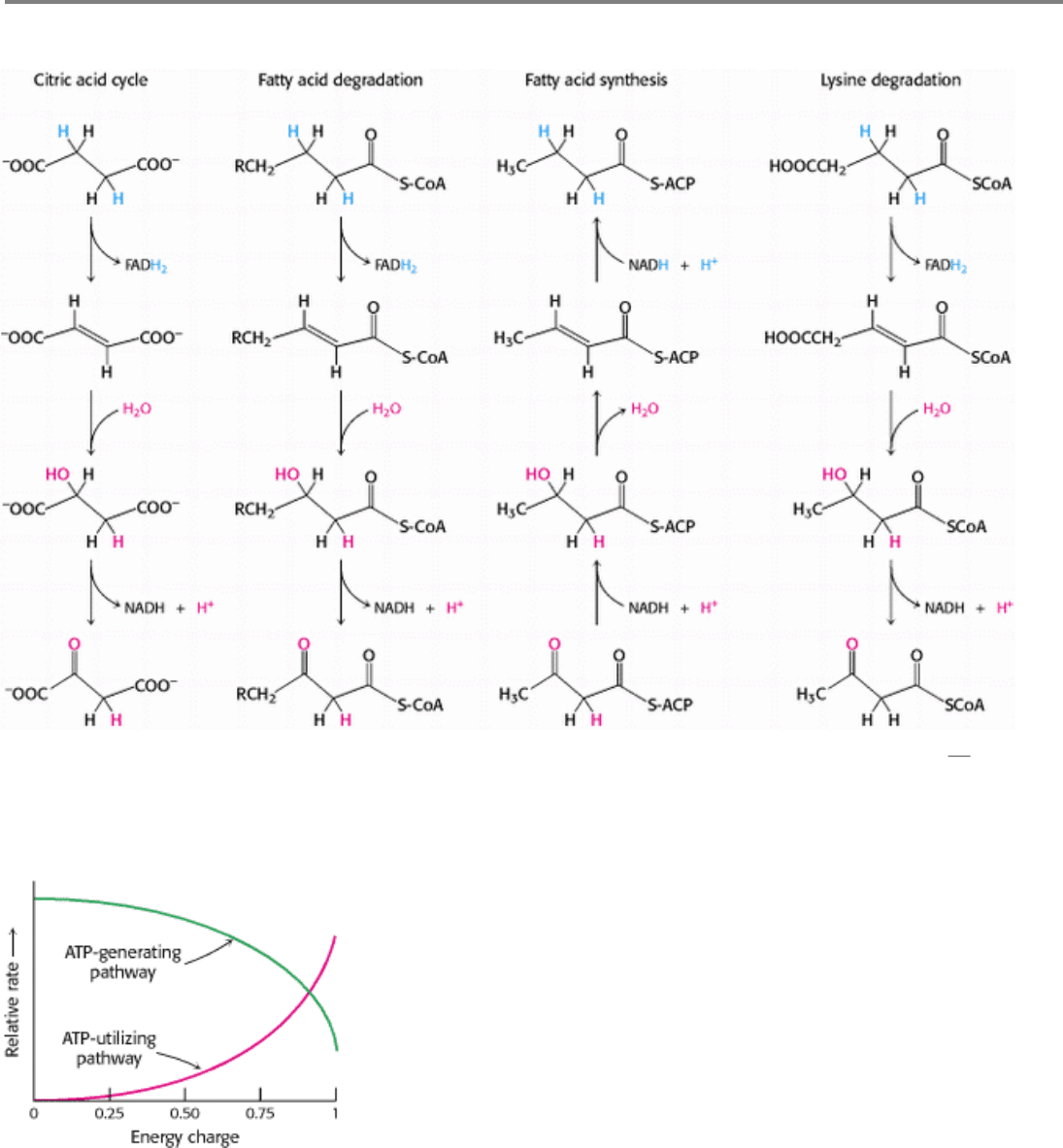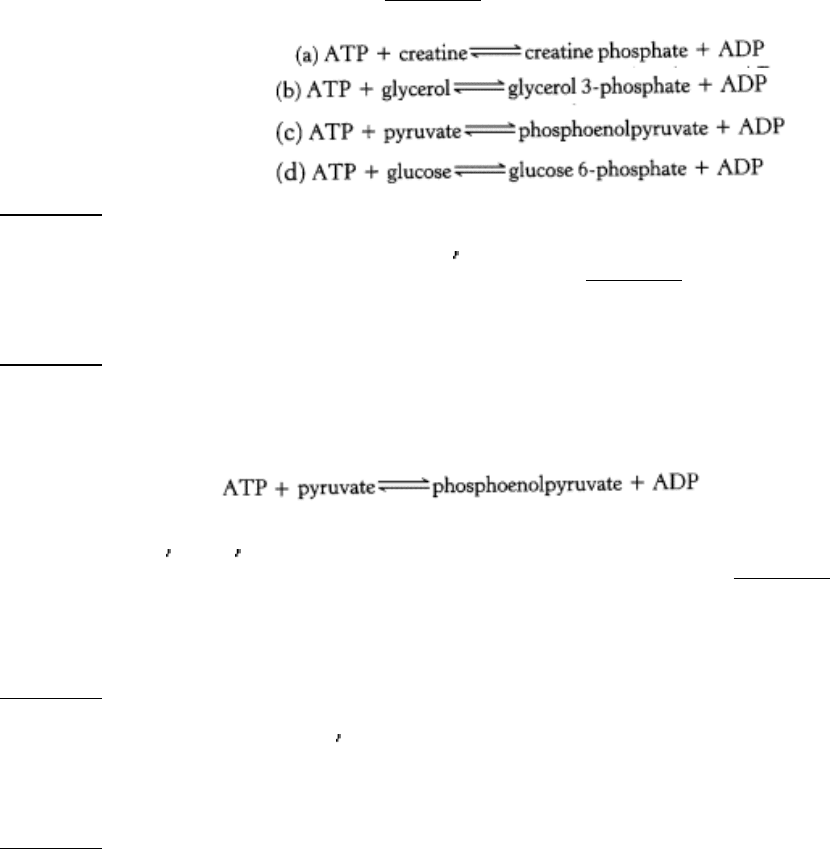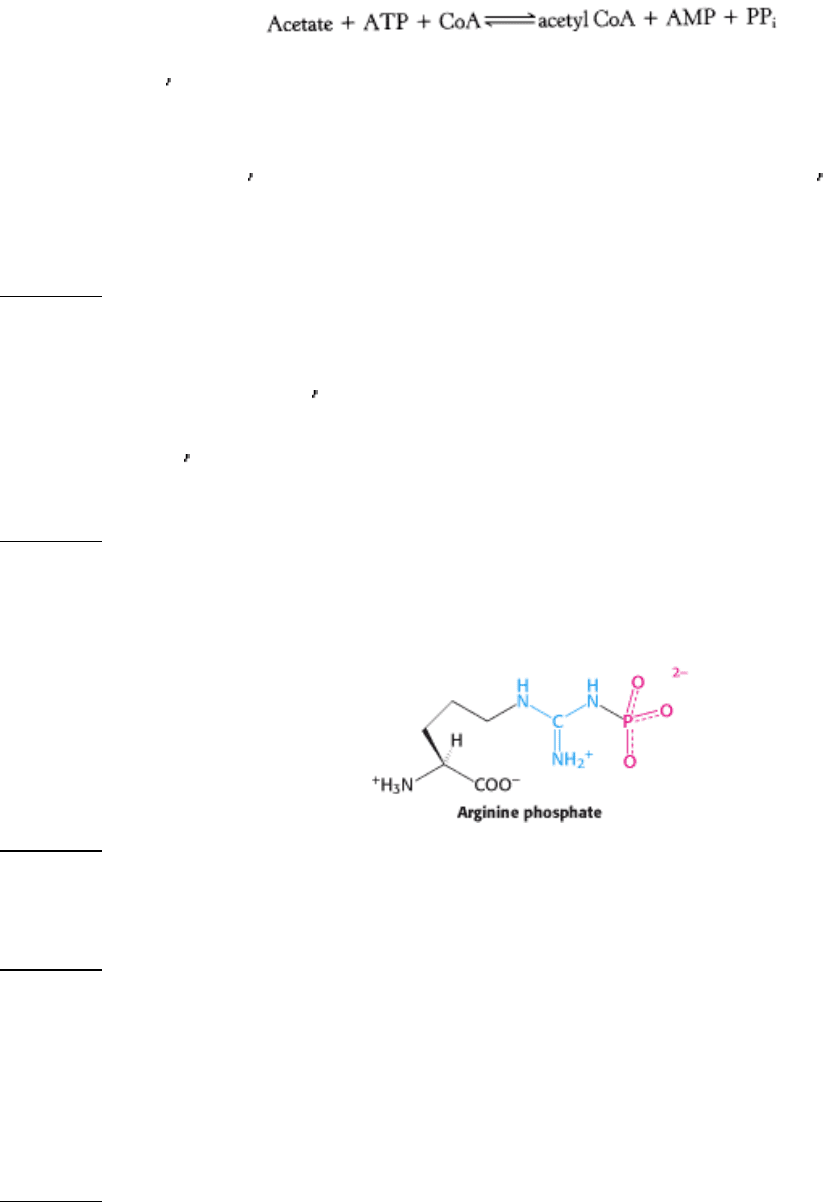Berg J.M., Tymoczko J.L., Stryer L. Biochemistry
Подождите немного. Документ загружается.


Addition or removal of functional groups Addition of functional groups to double bonds or their removal to form
double bonds
II. Transducing and Storing Energy 14. Metabolism: Basic Concepts and Design 14.3. Metabolic Pathways Contain Many Recurring Motifs
Figure 14.17. Metabolic Motifs. Some metabolic pathways have similar sequences of reactions in common
in this
case, an oxidation, the addition of a functional group (from a water molecule) to a double bond, and another oxidation.
ACP designates acyl carrier protein.
II. Transducing and Storing Energy 14. Metabolism: Basic Concepts and Design 14.3. Metabolic Pathways Contain Many Recurring Motifs
Figure 14.18. Energy Charge Regulates Metabolism. High concentrations of ATP inhibit the relative rates of a typical
ATP-generating (catabolic) pathway and stimulate the typical ATP-utilizing (anabolic) pathway.

II. Transducing and Storing Energy 14. Metabolism: Basic Concepts and Design 14.3. Metabolic Pathways Contain Many Recurring Motifs
Figure 14.19. Adenosine Diphosphate (ADP) Is an Ancient Module in Metabolism. This fundamental building block
is present in key molecules such as ATP, NADH, FAD, and coenzyme A. The adenine unit is shown in blue, the ribose
unit in red, and the diphosphate unit in yellow.
II. Transducing and Storing Energy 14. Metabolism: Basic Concepts and Design
Summary
All cells transform energy. They extract energy from their environment and use this energy to convert simple molecules
into cellular components.
Metabolism Is Composed of Many Coupled, Interconnecting Reactions
The process of energy transduction takes place through a highly integrated network of chemical reactions called
metabolism. Metabolism can be subdivided into catabolism (reactions employed to extract energy from fuels) and
anabolism (reactions that use this energy for biosynthesis). The most valuable thermodynamic concept for understanding
bioenergetics is free energy. A reaction can occur spontaneously only if the change in free energy (∆ G) is negative. A
thermodynamically unfavorable reaction can be driven by a thermodynamically favorable one, which in many cases is
the hydrolysis of ATP. The hydrolysis of ATP shifts the equilibrium of a coupled reaction by a factor of about 10
8
. ATP,
the universal currency of energy in biological systems, is an energy-rich molecule because it contains two
phosphoanhydride bonds.
The Oxidation of Carbon Fuels Is an Important Source of Cellular Energy
ATP formation is coupled to the oxidation of carbon fuels, either directly or through the formation of ion gradients.
Photosynthetic organisms can use light to generate such gradients. ATP is consumed in muscle contraction and other
motions of cells, in active transport, in signal transduction processes, and in biosyntheses. There are three stages in the
extraction of energy from foodstuffs by aerobic organisms. In the first stage, large molecules are broken down into
smaller ones, such as amino acids, sugars, and fatty acids. In the second stage, these small molecules are degraded to a
few simple units that have a pervasive role in metabolism. One of them is the acetyl unit of acetyl CoA, a carrier of
activated acyl groups. The third stage of metabolism is the citric acid cycle and oxidative phosphorylation, in which ATP
is generated as electrons flow to O
2
, the ultimate electron acceptor, and fuels are completely oxidized to CO
2
.
Metabolic Pathways Contain Many Recurring Motifs
Metabolism is characterized by common motifs. A small number of activated carriers, such as ATP, NADH, and acetyl
CoA, are used in many metabolic pathways. NADPH, which carries two electrons at a high potential, provides reducing
power in the biosynthesis of cell components from more-oxidized precursors. ATP and NADPH are continually
generated and consumed. Most transfers of activated groups in metabolism are mediated by a recurring set of carriers.
Moreover, key reaction types are used repeatedly in metabolic pathways.
Metabolism is regulated in a variety of ways. The amounts of some critical enzymes are controlled by regulation of the
rate of protein synthesis and degradation. In addition, the catalytic activities of many enzymes are regulated by allosteric
interactions (as in feedback inhibition) and by covalent modification. The movement of many substrates into cells and
subcellular compartments also is controlled. Distinct pathways for biosynthesis and degradation contribute to metabolic
regulation. The energy charge, which depends on the relative amounts of ATP, ADP, and AMP, plays a role in metabolic
regulation. A high-energy charge inhibits ATP-generating (catabolic) pathways, whereas it stimulates ATP-utilizing
(anabolic) pathways.
Key Terms
phototroph
chemotroph
metabolism or intermediary metabolism
catabolism
anabolism
amphibolic pathway
coupled reaction
phosphoryl transfer potential
oxidative phosphorylation
activated carrier
oxidation-reduction reaction

ligation reaction
isomerization reaction
group-transfer reaction
hydrolytic reaction
addition to or formation of double-bond reaction
energy charge
phosphorylation potential
II. Transducing and Storing Energy 14. Metabolism: Basic Concepts and Design
Problems
1.
Energy flow. What is the direction of each of the following reactions when the reactants are initially present in
equimolar amounts? Use the data given in Table 14.1.
See answer
2.
A proper inference. What information do the ∆ G° data given in Table 14.1 provide about the relative rates of
hydrolysis of pyrophosphate and acetyl phosphate?
See answer
3.
A potent donor. Consider the following reaction:
(a) Calculate ∆ G°
and K
eq
at 25°C for this reaction, by using the data given in Table 14.1.
(b) What is the equilibrium ratio of pyruvate to phosphoenolpyruvate if the ratio of ATP to ADP is 10?
See answer
4.
Isomeric equilibrium. Calculate ∆ G° for the isomerization of glucose 6-phosphate to glucose 1-phosphate. What is
the equilibrium ratio of glucose 6-phosphate to glucose 1-phosphate at 25°C?
See answer

5.
Activated acetate. The formation of acetyl CoA from acetate is an ATP-driven reaction:
(a) Calculate ∆ G°
for this reaction by using data given in this chapter.
(b) The PP
i
formed in the preceding reaction is rapidly hydrolyzed in vivo because of the ubiquity of inorganic
pyrophosphatase. The ∆ G°
for the hydrolysis of PP
i
is -4.6 kcal mol
-1
. Calculate the ∆ G° for the overall reaction.
What effect does the hydrolysis of PP
i
have on the formation of acetyl CoA?
See answer
6.
Acid strength. The pK of an acid is a measure of its proton-group-transfer potential.
(a) Derive a relation between ∆ G°
and pK.
(b) What is the ∆ G°
for the ionization of acetic acid, which has a pK of 4.8?
See answer
7.
Raison d'être. The muscles of some invertebrates are rich in arginine phosphate (phosphoarginine). Propose a
function for this amino acid derivative.
See answer
8.
Recurring motif. What is the structural feature common to ATP, FAD, NAD
+
, and CoA?
See answer
9.
Ergogenic help or hindrance? Creatine is a popular, but untested, dietary supplement.
(a) What is the biochemical rationale for the use of creatine?
(b) What type of exercise would most benefit from creatine supplementation?
See answer

10.
Standard conditions versus real life. The enzyme aldolase catalyzes the following reaction in the glycolytic
pathway:
The ∆ G°
for the reaction is +5.7 kcal mol
-1
, whereas the ∆ G in the cell is -0.3 kcal mol
-1
. Calculate the ratio of
reactants to products under equilibrium and intracellular conditions. Using your results, explain how the reaction
can be endergonic under standard conditions and exergonic under intracellular conditions.
See answer
11.
Not all alike. The concentrations of ATP, ADP, and P
i
differ with cell type. Consequently, the release of free
energy with the hydrolysis of ATP will vary with cell type. Using the following table, calculate the ∆ G for the
hydrolysis of ATP in muscle, liver, and brain cells. In which cell type is the free energy of ATP hydrolysis greatest?
See answer
12.
Running downhill. Glycolysis is a series of 10 linked reactions that convert one molecule of glucose into two
molecules of pyruvate with the concomitant synthesis of two molecules of ATP (Chapter 16). The ∆ G° for this set
of reactions is -8.5 kcal mol
-1
(-35.6 kJ mol
-1
), whereas the ∆ G is -18.3 kcal mol
-1
(-76.6 kJ mol
-1
). Explain why
the free-energy release is so much greater under intracellular conditions than under standard conditions.
See answer
Chapter Integration Problem
13.
Activated sulfate. Fibrinogen contains tyrosine-O-sulfate. Propose an activated form of sulfate that could react in
vivo with the aromatic hydroxyl group of a tyrosine residue in a protein to form tyrosine-O-sulfate.
See answer
Data Interpretation

14.
Opposites attract. The following graph shows how the ∆ G for the hydrolysis of ATP varies as a function of the
Mg
2+
concentration (pMg = log 1/[Mg
2+
]).
(a) How does decreasing [Mg
2+
] affect the ∆ G of hydrolysis for ATP?
(b) How can you explain this effect?
See answer
Media Problem
15.
Coupled reactions. The most obvious role of enzymes is to accelerate reactions, but a second critical role is
to couple reactions that would ordinarily be unrelated. From what you have learned from the text and the
Conceptual Insights module on energetic coupling, explain why the coupling of chemical reactions in a single
enzyme is critical for life.
II. Transducing and Storing Energy 14. Metabolism: Basic Concepts and Design
Selected Readings
Where to start
M.M. McGrane, J.S. Yun, Y.M. Patel, and R.W. Hanson. 1992. Metabolic control of gene expression: In vivo studies
with transgenic mice Trends Biochem. Sci. 17: 40-44. (PubMed)
Books
Harold, F. M., 1986. The Vital Force: A Study of Bioenergetics. W. H. Freeman and Company.
Krebs, H. A., and Kornberg, H. L., 1957. Energy Transformations in Living Matter. Springer Verlag.
Linder, M. C. (Ed.), 1991. Nutritional Biochemistry and Metabolism (2d ed.). Elsevier.
Gottschalk, G., 1986. Bacterial Metabolism (2d ed.). Springer Verlag.
Nicholls, D. G., and Ferguson, S. J., 1997. Bioenergetics 2 (2d ed.) Academic Press.
Martin, B. R., 1987. Metabolic Regulation: A Molecular Approach. Blackwell Scientific.
Frayn, K. N., 1996. Metabolic Regulation: A Human Perspective. Portland Press.

Fell, D., 1997. Understanding the Control of Metabolism. Portland Press.
Harris, D. A., 1995. Bioenergetics at a Glance. Blackwell Scientific.
Thermodynamics
Von Baeyer, H. C., 1999. Warmth Disperses and Time Passes: A History of Heat. Modern Library.
Edsall, J. T., and Gutfreund, H., 1983. Biothermodynamics: The Study of Biochemical Processes at Equilibrium. Wiley.
Klotz, I. M., 1967. Energy Changes in Biochemical Reactions. Academic Press.
Hill, T. L., 1977. Free Energy Transduction in Biology. Academic Press.
R.A. Alberty. 1993. Levels of thermodynamic treatment of biochemical reaction systems Biophys. J. 65: 1243-1254.
(PubMed)
R.A. Alberty and R.N. Goldberg. 1992. Standard thermodynamic formation properties for the adenosine 5
-triphosphate
series Biochemistry 31: 10610-10615. (PubMed)
R.A. Alberty. 1968. Effect of pH and metal ion concentration on the equilibrium hydrolysis of adenosine triphosphate to
adenosine diphosphate J. Biol. Chem. 243: 1337-1343. (PubMed)
Goldberg, R. N., 1984. Compiled Thermodynamic Data Sources for Aqueous and Biochemical Systems: An Annotated
Bibliography (1930-1983). National Bureau of Standards Special Publication 685, U.S. Government Printing Office.
P.A. Frey and A. Arabshahi. 1995. Standard free energy change for the hydrolysis of the α, β-phosphoanhydride bridge
in ATP Biochemistry 34: 11307-11310. (PubMed)
F.H. Westheimer. 1987. Why nature chose phosphates Science 235: 1173-1178. (PubMed)
Bioenergetics and metabolism
C.H. Schilling, D. Letscher, and B.O. Palsson. 2000. Theory for the systemic definition of metabolic pathways and their
use in interpreting metabolic function from a pathway-oriented perspective J. Theor. Biol. 203: 229-248. (PubMed)
T.E. DeCoursey and V.V. Cherny. 2000. Common themes and problems of bioenergetics and voltage-gated proton
channels Biochim. Biophys. Acta. 1458: 104-119. (PubMed)
C. Giersch. 2000. Mathematical modelling of metabolism Curr. Opin. Plant Biol. 3: 249-253. (PubMed)
D.C. Rees and J.B. Howard. 1999. Structural bioenergetics and energy transduction mechanisms J. Mol. Biol. 293: 343-
350. (PubMed)
Regulation of metabolism
G.J. Kemp. 2000. Studying metabolic regulation in human muscle Biochem. Soc. Trans. 28: 100-103. (PubMed)
H.C. Towle, E.N. Kaytor, and H.M. Shih. 1996. Metabolic regulation of hepatic gene expression Biochem. Soc. Trans.
24: 364-368. (PubMed)
J.H. Hofmeyr. 1995. Metabolic regulation: A control analytic perspective J. Bioenerg. Biomembr. 27: 479-490.
(PubMed)
Atkinson, D. E., 1977. Cellular Energy Metabolism and Its Regulation. Academic Press.
M. Ereci ska and D.F. Wilson. 1978. Homeostatic regulation of cellular energy metabolism Trends Biochem. Sci. 3: 219-

223.
Historical aspects
H.M. Kalckar. 1991. 50 years of biological research: From oxidative phosphorylation to energy requiring transport
regulation Annu. Rev. Biochem. 60: 1-37. (PubMed)
Kalckar, H. M. (Ed.), 1969. Biological Phosphorylations. Prentice Hall.
Fruton, J. S., 1972. Molecules and Life. Wiley-Interscience.
Lipmann, F., 1971. Wanderings of a Biochemist. Wiley-Interscience.
II. Transducing and Storing Energy
15. Signal-Transduction Pathways: An Introduction to Information
Metabolism
A cell is highly responsive to specific chemicals in its environment. Hormones are chemical signals that tell a cell to
respond to a change in conditions. Molecules in food or aromas communicate taste and smell through their interaction
with specialized sensory cells. This chapter provides an overview of information metabolism
how cells receive,
process, and respond to information from the environment. The results of genome-sequencing efforts have underscored
how widespread and diverse these information-processing circuits are. For example, approximately half of the 25 largest
protein families encoded by the human genome deal primarily with information processing.
Signal-transduction cascades mediate the sensing and processing of stimuli. These molecular circuits detect, amplify,
and integrate diverse external signals to generate responses such as changes in enzyme activity, gene expression, or ion-
channel activity. This chapter is an introduction to some of the most important classes of molecules that participate in
common signal-transduction pathways. We will encounter many specific pathways in their biochemical contexts in later
chapters. In this chapter, we will also consider the consequences of defects in these pathways, particularly those leading
to cancer.
15.0.1. Signal Transduction Depends on Molecular Circuits: An Overview
Signal-transduction pathways follow a broadly similar course that can be viewed as a molecular circuit (Figure 15.1). We
begin by examining the challenges posed by transferring extracellular information to a cell's interior.
1. Membrane receptors transfer information from the environment to the cell's interior. A few nonpolar signal molecules
such as estrogens and other steroid hormones are able to diffuse through the cell membranes and, hence, enter the cell.
Once inside the cell, these molecules can bind to proteins that interact directly with DNA and modulate gene
transcription. Thus, a chemical signal enters the cell and directly alters gene-expression patterns. These important
signaling systems will be discussed in Chapter 31. However, most signal molecules are too large and too polar to pass
through the membrane, and no appropriate transport systems are present. Thus, the information that signal molecules are
present must be transmitted across the cell membrane without the molecules themselves entering the cell. A membrane-
associated receptor protein often performs the function of information transfer across the membrane.

Such a receptor is an intrinsic membrane protein that has both extracellular and intracellular domains. A binding site on
the extracellular domain specifically recognizes the signal molecule (often referred to as the ligand). Such binding sites
are analogous to enzyme active sites except that no catalysis takes place within them. The interaction of the ligand and
the receptor alters the tertiary or quaternary structure of the receptor, including the intracellular domain. These structural
changes are not sufficient to yield an appropriate response, because they are restricted to a small number of receptor
molecules in the cell membrane. The information embodied by the presence of the ligand, often called the primary
messenger, must be transduced into other forms that can alter the biochemistry of the cell.
2. Second messengers relay information from the receptor-ligand complex. Changes in the concentration of small
molecules, called second messengers, constitute the next step in the molecular information circuit. Particularly important
second messengers include cyclic AMP and cyclic GMP, calcium ion, inositol 1,4,5-trisphosphate, (IP
3
), and
diacylglycerol (DAG; Figure 15.2).
The use of second messengers has several consequences. First, second messengers are often free to diffuse to other
compartments of the cell, such as the nucleus, where they can influence gene expression and other processes. Second, the
signal may be amplified significantly in the generation of second messengers. Enzymes or membrane channels are
almost always activated in second-messenger generation; each activated macromolecule can lead to the generation of
many second messengers within the cell. Thus, a low concentration of signal in the environment, even as little as a
single molecule, can yield a large intracellular signal and response. Third, the use of common second messengers in
multiple signaling pathways creates both opportunities and potential problems. Input from several signaling pathways,
often called cross talk, may affect the concentrations of common second messengers. Cross talk permits more finely
tuned regulation of cell activity than would the action of individual independent pathways. However, inappropriate cross
talk can cause second messengers to be misinterpreted.
3. Protein phosphorylation is a common means of information transfer. Many second messengers elicit responses by
activating protein kinases. These enzymes transfer phosphoryl groups from ATP to specific serine, threonine, and
tyrosine residues in proteins.
